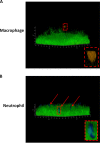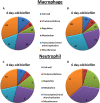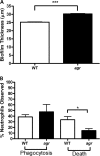Global transcriptome analysis of Staphylococcus aureus biofilms in response to innate immune cells
- PMID: 24042108
- PMCID: PMC3837966
- DOI: 10.1128/IAI.00819-13
Global transcriptome analysis of Staphylococcus aureus biofilms in response to innate immune cells
Abstract
The potent phagocytic and microbicidal activities of neutrophils and macrophages are among the first lines of defense against bacterial infections. Yet Staphylococcus aureus is often resistant to innate immune defense mechanisms, especially when organized as a biofilm. To investigate how S. aureus biofilms respond to macrophages and neutrophils, gene expression patterns were profiled using Affymetrix microarrays. The addition of macrophages to S. aureus static biofilms led to a global suppression of the biofilm transcriptome with a wide variety of genes downregulated. Notably, genes involved in metabolism, cell wall synthesis/structure, and transcription/translation/replication were among the most highly downregulated, which was most dramatic at 1 h compared to 24 h following macrophage addition to biofilms. Unexpectedly, few genes were enhanced in biofilms after macrophage challenge. Unlike coculture with macrophages, coculture of S. aureus static biofilms with neutrophils did not greatly influence the biofilm transcriptome. Collectively, these experiments demonstrate that S. aureus biofilms differentially modify their gene expression patterns depending on the leukocyte subset encountered.
Figures








Similar articles
-
Staphylococcus aureus biofilms prevent macrophage phagocytosis and attenuate inflammation in vivo.J Immunol. 2011 Jun 1;186(11):6585-96. doi: 10.4049/jimmunol.1002794. Epub 2011 Apr 27. J Immunol. 2011. PMID: 21525381 Free PMC article.
-
Staphylococcus aureus Biofilm-Conditioned Medium Impairs Macrophage-Mediated Antibiofilm Immune Response by Upregulating KLF2 Expression.Infect Immun. 2019 Mar 25;87(4):e00643-18. doi: 10.1128/IAI.00643-18. Print 2019 Apr. Infect Immun. 2019. PMID: 30692179 Free PMC article.
-
Staphylococcus aureus Biofilms Induce Macrophage Dysfunction Through Leukocidin AB and Alpha-Toxin.mBio. 2015 Aug 25;6(4):e01021-15. doi: 10.1128/mBio.01021-15. mBio. 2015. PMID: 26307164 Free PMC article.
-
Staphylococci evade the innate immune response by disarming neutrophils and forming biofilms.FEBS Lett. 2020 Aug;594(16):2556-2569. doi: 10.1002/1873-3468.13767. Epub 2020 Mar 19. FEBS Lett. 2020. PMID: 32144756 Review.
-
Epic Immune Battles of History: Neutrophils vs. Staphylococcus aureus.Front Cell Infect Microbiol. 2017 Jun 30;7:286. doi: 10.3389/fcimb.2017.00286. eCollection 2017. Front Cell Infect Microbiol. 2017. PMID: 28713774 Free PMC article. Review.
Cited by
-
Omics Approaches for the Study of Adaptive Immunity to Staphylococcus aureus and the Selection of Vaccine Candidates.Proteomes. 2016 Mar 7;4(1):11. doi: 10.3390/proteomes4010011. Proteomes. 2016. PMID: 28248221 Free PMC article. Review.
-
Biofilm and the Role of Antibiotics in the Treatment of Periprosthetic Hip and Knee Joint Infections.Open Orthop J. 2016 Nov 30;10:636-645. doi: 10.2174/1874325001610010636. eCollection 2016. Open Orthop J. 2016. PMID: 28484579 Free PMC article.
-
FmhA and FmhC of Staphylococcus aureus incorporate serine residues into peptidoglycan cross-bridges.J Biol Chem. 2020 Sep 25;295(39):13664-13676. doi: 10.1074/jbc.RA120.014371. Epub 2020 Aug 5. J Biol Chem. 2020. PMID: 32759309 Free PMC article.
-
Ventricular shunt infections: immunopathogenesis and clinical management.J Neuroimmunol. 2014 Nov 15;276(1-2):1-8. doi: 10.1016/j.jneuroim.2014.08.006. Epub 2014 Aug 13. J Neuroimmunol. 2014. PMID: 25156073 Free PMC article. Review.
-
Staphylococcal Biofilms and Immune Polarization During Prosthetic Joint Infection.J Am Acad Orthop Surg. 2017 Feb;25 Suppl 1(Suppl 1):S20-S24. doi: 10.5435/JAAOS-D-16-00636. J Am Acad Orthop Surg. 2017. PMID: 27922945 Free PMC article. Review.
References
-
- Bronner S, Monteil H, Prevost G. 2004. Regulation of virulence determinants in Staphylococcus aureus: complexity and applications. FEMS Microbiol. Rev. 28:183–200 - PubMed
-
- Novick RP. 2003. Autoinduction and signal transduction in the regulation of staphylococcal virulence. Mol. Microbiol. 48:1429–1449 - PubMed
-
- Arciola CR, Campoccia D, Speziale P, Montanaro L, Costerton JW. 2012. Biofilm formation in Staphylococcus implant infections. A review of molecular mechanisms and implications for biofilm-resistant materials. Biomaterials 33:5967–5982 - PubMed
-
- Kiedrowski MR, Horswill AR. 2011. New approaches for treating staphylococcal biofilm infections. Ann. N. Y. Acad. Sci. 1241:104–121 - PubMed
-
- Whitchurch CB, Tolker-Nielsen T, Ragas PC, Mattick JS. 2002. Extracellular DNA required for bacterial biofilm formation. Science 295:1487. - PubMed
Publication types
MeSH terms
Substances
Associated data
- Actions
Grants and funding
LinkOut - more resources
Full Text Sources
Other Literature Sources
Medical
Molecular Biology Databases

